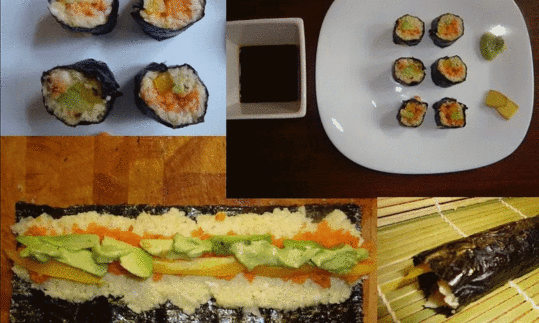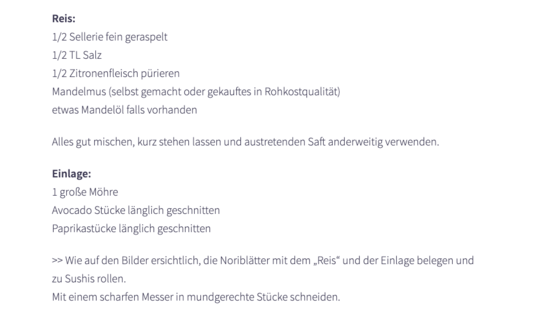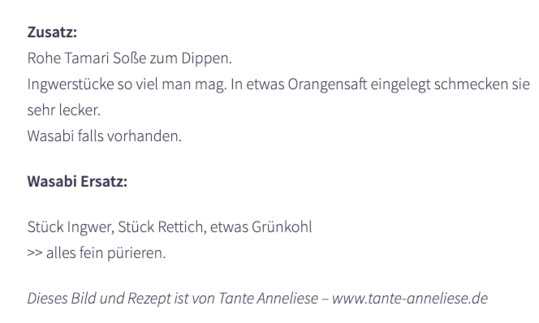Sushi with celery rice and ginger-radish-wasabi
raw-vegan
Ingredients (for servings, )
| For the celery rice | |
|---|---|
| ½ | Celeriac, raw (organic?) (15 oz) |
| ½ | Lemons, raw (limes, organic?) (1.0 oz) |
| ⅓ oz | Walnuts (tree nuts), raw (organic?) |
| 1 dash | Table salt (table salt, raw?, organic?) (0.01 oz) |
| For the filling | |
| 1 large | Carrots (carrots), raw (organic?) (5.8 oz) |
| ¼ | Avocados, raw (organic?) (1.8 oz) |
| ¼ | Sweet pepper, yellow, raw (organic?) (1.4 oz) |
| For the ginger-radish-wasabi | |
| 1 cm | Ginger, raw (organic?) (0.38 oz) |
| ⅓ oz | Garden radishes, raw (organic?) |
| 1 leaves | Kale, raw (spring cabbage, organic?) (0.91 oz) |
| For rolling up | |
| 2 | Nori sheets (raw? organic?) (0.19 oz) |
Equipment
- coffee grinder, electric or shredder
- hand-held blender / immersion blender
- grater
- vegetable peeler
- citrus juicer (lemon squeezer)
- makisu (bamboo mat)
Type of preparation
- chop or grind
- food preparation without heating
- meld
- purée
- peel
- grate (shred)
Preparation
For the celery rice
Peel and grate the celery. Peel half the lemon and puree the lemon flesh. Process the walnuts in a coffee grinder or food processor to make a nut butter.In the original recipe, we use ½ teaspoon of salt and almond butter for the amount we designed for 2 portions . We replaced the latter with walnuts. The reason for the two changes can be found under Notes.
Mix all the ingredients for the celery rice well, let it stand for a short while and use the juice that comes out for something else.
For the filling
Clean and grate the carrot. Peel the avocado and cut into long pieces. Wash the pepper and cut into long strips.The original recipe does not specify the amounts of avocado and pepper, so you have to decide for yourself.
For the ginger-radish-wasabi
Peel the ginger and radish and cut into small pieces. Wash the kale. Puree everything together and set aside.The original recipe does not specify the amounts of ginger, radish and kale. So decide for yourself. You can also use a radish other than the garden radish.
To finish the sushi rolls
Spread half of the celery rice on the matte side of the nori sheet until it covers about ⅔ of the surface. Place the grated carrots on top, then the peppers and avocado.Be sure to use raw nori sheets instead of the usual toasted ones. See notes.
Starting from the end of the leaf (the end closest to you with the filling), roll everything up. Moisten the top end with water and when everything is rolled up, press it together briefly. Repeat this with the second roll.
You can use a bamboo mat (makisu) to roll it up - this makes it easier to get firm rolls.
serving
Using a clean, sharp knife, cut each roll into about 5 pieces and serve with the ginger-radish-wasabi.
|
Nutritional Information per person
Convert per 100g
|
2000 kcal | |
|---|---|---|
| Energy | 229 kcal | 11.4% |
| Fat/Lipids | 8.2 g | 11.6% |
| Saturated Fats | 1.1 g | 5.6% |
| Carbohydrates (inc.dietary fiber) | 36 g | 13.5% |
| Sugars | 8.5 g | 9.4% |
| Fiber | 9.7 g | 38.9% |
| Protein/Albumin | 7.5 g | 15.1% |
| Cooking Salt (Na:398.2 mg) | 1'011 mg | 42.1% |
| Essential micronutrients with the highest proportions | per person | 2000 kcal | |
|---|---|---|---|
| Vit | Vitamin K | 198 µg | 264.0% |
| Vit | Vitamin C (ascorbic acid) | 88 mg | 110.0% |
| Vit | Vitamin A, as RAE | 768 µg | 96.0% |
| Elem | Potassium, K | 1'240 mg | 62.0% |
| Vit | Vitamin B9, B11 (Folate, as the active form of folic acid) | 117 µg | 59.0% |
| Min | Copper, Cu | 0.58 mg | 58.0% |
| Sodium, Na | 398 mg | 50.0% | |
| Elem | Phosphorus, P | 333 mg | 48.0% |
| Vit | Vitamin B6 (pyridoxine) | 0.67 mg | 48.0% |
| Min | Manganese, Mn | 0.83 mg | 41.0% |
Detailed Nutritional Information per Person for this Recipe
The majority of the nutritional information comes from the USDA (US Department of Agriculture). This means that the information for natural products is often incomplete or only given within broader categories, whereas in most cases products made from these have more complete information displayed.
If we take flaxseed, for example, the important essential amino acid ALA (omega-3) is only included in an overarching category whereas for flaxseed oil ALA is listed specifically. In time, we will be able to change this, but it will require a lot of work. An “i” appears behind ingredients that have been adjusted and an explanation appears when you hover over this symbol.
For Erb Muesli, the original calculations resulted in 48 % of the daily requirement of ALA — but with the correction, we see that the muesli actually covers >100 % of the necessary recommendation for the omega-3 fatty acid ALA. Our goal is to eventually be able to compare the nutritional value of our recipes with those that are used in conventional western lifestyles.
| Essential fatty acids | per person | 2000 kcal |
|---|---|---|
| Linoleic acid; LA; 18:2 omega-6 | 2.8 g | 28.0% |
| Alpha-Linolenic acid; ALA; 18:3 omega-3 | 0.52 g | 26.0% |
| Essential amino acids | per person | 2000 kcal |
|---|---|---|
| Threonine (Thr, T, irreversibly transaminated) | 0.22 g | 24.0% |
| Tryptophan (Trp, W) | 0.03 g | 14.0% |
| Isoleucine (Ile, I) | 0.14 g | 11.0% |
| Valin (Val, V) | 0.16 g | 10.0% |
| Leucine (Leu, L) | 0.21 g | 9.0% |
| Lysine (Lys, K, irreversibly transaminated) | 0.16 g | 9.0% |
| Phenylalanine (Phe, F) | 0.13 g | 9.0% |
| Methionine (Met, M) | 0.05 g | 5.0% |
| Vitamins | per person | 2000 kcal |
|---|---|---|
| Vitamin K | 198 µg | 264.0% |
| Vitamin C (ascorbic acid) | 88 mg | 110.0% |
| Vitamin A, as RAE | 768 µg | 96.0% |
| Vitamin B9, B11 (Folate, as the active form of folic acid) | 117 µg | 59.0% |
| Vitamin B6 (pyridoxine) | 0.67 mg | 48.0% |
| Vitamin B5 (Pantothenic acid) | 1.5 mg | 25.0% |
| Vitamin B1 (Thiamine) | 0.23 mg | 21.0% |
| Vitamin B3 (Niacin) | 3.4 mg | 21.0% |
| Vitamin B2 (Riboflavin) | 0.27 mg | 20.0% |
| Vitamin E, as a-TEs | 2.3 mg | 19.0% |
| Vitamin B7 (Biotin, ex vitamin H) | 6.0 µg | 12.0% |
| Essential macroelements (macronutrients) | per person | 2000 kcal |
|---|---|---|
| Potassium, K | 1'240 mg | 62.0% |
| Sodium, Na | 398 mg | 50.0% |
| Phosphorus, P | 333 mg | 48.0% |
| Magnesium, Mg | 101 mg | 27.0% |
| Calcium, Ca | 184 mg | 23.0% |
| Essential trace elements (micronutrients) | per person | 2000 kcal |
|---|---|---|
| Copper, Cu | 0.58 mg | 58.0% |
| Manganese, Mn | 0.83 mg | 41.0% |
| Iron, Fe | 2.9 mg | 21.0% |
| Zinc, Zn | 1.6 mg | 16.0% |
| Iod, I (Jod, J) | 12 µg | 8.0% |
| Selenium, Se | 2.3 µg | 4.0% |
| Fluorine, F | 20 µg | 1.0% |
The raw vegan sushi with celery rice and ginger-radish-wasabi is filled with pepper, avocado and carrot.
Nutrient profile: According to GDA guidelines, one portion covers more than twice the average daily requirement of vitamin K and more than 100% of that of vitamin C. Vitamin A, potassium, iodine and copper are covered by more than 50%. We were able to increase the fatty acid values by replacing almond butter with walnuts. Their ratio is now 5:1, which does not exceed the recommended maximum ratio of 5:1. We have reduced the salt content by making adjustments.
You can find more information behind this motivation at the following link: Vegans often eat unhealthily. Avoidable nutritional errors.
Nori: Nori is a sweet-tasting, wafer-thin roasted or dried seaweed. It is available in the form of square, paper-like sheets, mostly made from red algae of the species Porphyra yezoensis or Porphyra tenera. Green nori, which you can buy in stores for sushi, is roasted and not raw. However, you can also buy raw nori sheets, which are dark brown instead of green.
Celery: Celeriac is a cultivated form of marsh celery. Like the two other varieties of real celery, celery and celery, celeriac is used in the kitchen as a vegetable. Celeriac has a spicy taste that stimulates the appetite and digestion, which it owes to its essential oils. In naturopathy, it is used to support rheumatism, stomach and intestinal disorders, and kidney and bladder problems.
Carrots and vitamin A: Carrots are one of the low-calorie vegetables. They are particularly rich in carotene, a precursor to vitamin A, which gives them their typical orange color. Vitamin A is important for our eyesight, among other things, but also for the immune system.
Avocados: Avocados have a higher fat content than any other known fruit and vegetable. They are also rich in potassium and unsaturated fatty acids, although the ratio of LA:ALA is not optimal at 15:1. For information on how to prevent browning and storage, see Tips.
Nori and iodine: Most nori comes from specially cultivated algae cultures in Japan and Korea. You should eat the algae in moderation, as they have a high iodine content. Iodine is an essential trace element that is particularly necessary for the production of certain thyroid hormones. A deficiency results in an underactive thyroid, but too much intake can overwhelm the thyroid and be harmful to health. The iodine content in algae varies depending on the variety, harvest time, place of growth and processing. You can find more information on the ingredient iodine.
Preventing avocado and celery from turning brown: Cutting celery and avocado causes a break in the affected cell walls, which exposes the ingredients to the oxidation process. This in turn causes the fruit to turn brown. Adding lemon or lime juice can prevent this and also adds a good taste to the dish.
Storage of avocados: Avocados are harvested when they are unripe. To ripen them, it is best to place avocados next to apples (or put them together in a paper bag) and store them at room temperature. The apple emits the gas ethylene, which promotes ripening.
Soy sauce for dipping: Nama Shoyu is a good dipping sauce. Compared to other soy sauces, it is unpasteurized; it is not heated at the end of the maturing process, but rather simply filtered, which is why it is often used in raw food cooking. However, we do not generally consider soy sauce to be a raw food, since soybeans are heated at the beginning of the production process in order to destroy the glycoprotein phasin, which is toxic to humans.
Additional ginger pieces, marinated in a little orange juice, also taste very delicious with celery sushi.
Filling: You can make raw sushi in many different ways. Depending on your taste, season and location, the filling can be varied: cucumbers, tomatoes, peppers, zucchini, etc.
For the rice substitute: As a "rice substitute" you can use cauliflower instead of celery. You can also add any herbs you like.
Wasabi: Instead of the wasabi substitute, you can also use commercial wasabi.
You can find another raw sushi recipe here: Raw sushi with celery filling and sunflower seeds







